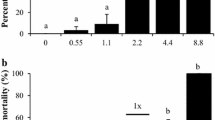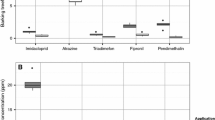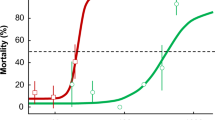Abstract
Recent studies have demonstrated that a pyraclostrobin-containing fungicide (Headline® Fungicide—Headline® Fungicide and Headline AMP® Fungicide are registered trademarks of BASF) is toxic to amphibians at environmentally relevant concentrations. However, these studies were performed in a laboratory setting of a worst-case direct exposure in clean media. Interception of spray by the crop canopy and ground cover used by animals for security cover will influence exposure. Thus, risk to amphibians is unclear in an environmentally realistic field environment. We tested exposure and toxicity of Headline AMP® Fungicide to amphibians in multiple agricultural habitat scenarios (e.g., within treated crop vs. grassy areas adjacent to crop) and at two rates during routine aerial application. Specifically, we placed Woodhouse’s toads (Bufo woodhousii) and Blanchard’s cricket frogs (Acris blanchardi) in enclosures located within treated and untreated corn (VT stage, approximate height = 3 m), and in the potential drift area (adjacent to treated corn) during aerial application of Headline AMP Fungicide at either 731 or 1052 ml/ha (70 and 100 % the maximum application rate in corn, respectively). Mean concentrations of pyraclostrobin measured at ground level were ≤19 % of nominal application rate in all areas. Overall, mean mortality of recovered individuals of both species was ≤15 %, and mortality within Headline AMP Fungicide-treated corn (where risk was anticipated to be highest) was <10 %. It is important to understand that application timing, interception by the crop canopy (which varies both within and between crop systems), and timing of amphibian presence in the crop field influences risk of exposure and effects; however, our results demonstrate that amphibians inhabiting VT stage corn during routine aerial application of Headline AMP Fungicide are at low risk for acute mortality, matching existing laboratory results from acute toxicity studies of Headline Fungicide.




Similar content being viewed by others
References
Attademo AM, Peltzer PM, Lajmanovich RC (2005) Amphibians occurring in soybean and implications for biological control in Argentina. Agr Ecosyst Environ 106(4):389–394. doi:10.1016/j.agee.2004.08.012
BASF Corporation (2008) Headline® Fungicide supplemental label. NVA 2008-04- 088-0327. Research Triangle Park, NC. http://agproducts.basf.us/products/label-and-msds/headline-fungicide-supp-label-4.pdf
BASF Corporation (2012) Headline AMP® Fungicide label. NVA 2012-04-343-0153. Research Triangle Park, NC. http://agproducts.basf.us/products/label-and-msds/headline-amp-fungicide-label.pdf
BASF Corporation (2013a) Priaxor® Fungicide label. NVA 2012-04-372-0228. Research Triangle Park, NC. http://agproducts.basf.us/products/label-and-msds/priaxor-fungicide-label.pdf
BASF Corporation (2013b) Corn fungicide solution guide. APN#13-02-013. http://www.agproducts.basf.us/products/research-library/sequential-corn-technical-information-bulletin.pdf
Belden J, McMurry S, Smith L, Reilley P (2010) Acute toxicity of fungicide formulations to amphibians at environmentally relevant concentrations. Environ Toxicol Chem 29:2477–2480. doi:10.1002/etc.297
Berger G, Graef F, Pfeffer H (2013) Glyphosate applications on arable fields considerably coincide with migrating amphibians. Sci Rep 3:2622
Bishop AA, Vrtiska M (2008) Effects of the wetlands reserve program on waterfowl carrying capacity in the rainwater basin region of south-central Nebraska. US Fish and Wildlife Service, Grand Island
Breden F (1987) The effect of post-metamorphic dispersal on the population genetic structure of Fowler’s toad, Bufo woodhousei fowleri. Copeia 1987(2):386–395. doi:10.2307/1445775
Bross M, Mackenroth C (2005) Summary of residue data and MRL proposals supporting the use of BAS 500 F containing formulations in multiple fruit and vegetable crops. BASF 2005/1023124; In: Pyraclostrobin (210). http://www.fao.org/fileadmin/templates/agphome/documents/Pests_Pesticides/JMPR/Evaluation06/Pyraclostrobin06.pdf. Accessed 29 April 2014
Brühl CA, Schmidt T, Pieper S, Alscher A (2013) Terrestrial pesticide exposure in amphibians: an underestimated cause of global decline? Sci Rep 3:1135. doi:10.1038/srep01135
Daughtry C, Gallo K, Goward S, Prince S, Kustas W (1992) Spectral estimates of absorbed radiation and phytomass production in corn and soybean canopies. Remote Sens Environ 39(2):141–152. doi:10.1016/0034-4257(92)90132-4
Duellman WE, Trueb L (1986) Biology of the amphibians. John Hopkins University Press, Baltimore
FOCUS (2000) “FOCUS groundwater scenarios in the EU review of active substances” Report of the FOCUS Groundwater Scenarios Workgroup, EC document reference Sanco/321/2000 rev.2, 202 pp
Gray MJ, Smith LM, Brenes R (2004) Effects of agricultural cultivation on demographics of southern high plains amphibians. Conserv Biol 18(5):1368–1377. doi:10.1111/j.1523-1739.2004.00089.x
Hooser EA, Belden JB, Smith LM, McMurry ST (2012) Acute toxicity of three strobilurin fungicide formulations and their active ingredients to tadpoles. Ecotoxicology 21(5):1458–1464. doi:10.1007/s10646-012-0899-y
Lannoo MJ (2005) Amphibian declines: the conservation status of United States species. University of California Press, Oakland
Lemmon PE (1956) A spherical densiometer for estimating forest overstory density. Forest Sci 2(4):314–320
Lenhardt PP, Brühl CA, Berger G (2015) Temporal coincidence of amphibian migration and pesticide applications on arable fields in spring. Basic Appl Ecol 16(1):54–63
McClanahan L Jr, Baldwin R (1969) Rate of water uptake through the integument of the desert toad, Bufo punctatus. Comp Biochem Physiol 28(1):381–389. doi:10.1016/0010-406X(69)91351-6
Olesen MH, Jensen PK (2013) Collection and evaluation of relevant information on crop interception. EFSA Supporting Publication 2013: EN-438
Pechmann JK, Estes R, Scott D, Gibbons JW (2001) Amphibian colonization and use of ponds created for trial mitigation of wetland loss. Wetlands 21(1):93–111
Quinn N, Laflen J (1983) Characteristics of raindrop throughfall under corn canopy. Trans ASAE 26(5):1445–1450
Regenstein H (2006) Pyraclostrobin, dossier for the second residue JMPR evaluation. BASF: 2006/1009448. In: Pyraclostrobin (210). http://www.fao.org/fileadmin/templates/agphome/documents/Pests_Pesticides/JMPR/Evaluation06/Pyraclostrobin06.pdf. Accessed 29 April 2014
Ruibal R, Tevis L Jr, Roig V (1969) The terrestrial ecology of the spadefoot toad Scaphiopus hammondii. Copeia 1969:571–584. doi:10.2307/1441937
Salyani M, Cromwell R (1992) Spray drift from ground and aerial applications. Tran ASAE 35(4):1113–1120
Seebacher F, Alford RA (2002) Shelter microhabitats determine body temperature and dehydration rates of a terrestrial amphibian (Bufo marinus). J Herpetol 36(1):69–75
Semlitsch RD (2008) Differentiating migration and dispersal processes for pond-breeding amphibians. J Wildlife Manage 72(1):260–267. doi:10.2193/2007-082
Seymour RS (1973) Physiological correlates of forced activity and burrowing in the spadefoot toad, Scaphiopus hammondii. Copeia 1973:103–115. doi:10.2307/1442364
Teske ME, Bird SL, Esterly DM, Curbishley TB, Ray SL, Perry SG (2002) AgDrift®: a model for estimating near-field spray drift from aerial applications. Environ Toxicol Chem 21(3):659–671. doi:10.1002/etc.5620210327
Tiner R (2003) Geographically isolated wetlands of the United States. Wetlands 23(3):494–516
US Environmental Protection Agency (2013) ECOTOX user guide: ECOTOXicology Database System. Version 4.0. [cited 21 March 2015]. Available at: http://cfpub.epa.gov/ecotox/
Vos CC, Goedhart PW, Lammertsma DR, Spitzen-Van der Sluijs AM (2007) Matrix permeability of agricultural landscapes: an analysis of movements of the common frog (Rana temporaria). Herpetol J 17(3):174–182
Zar J (2009) Biostatistical Analysis, 5th. Prentice Hall, Upper Saddle River
Acknowledgments
Funding for this research was provided by BASF Corporation. We thank T. Raskevitz and D. Daniel for help collecting animals and assistance during data collection. Animals were collected under Oklahoma Department of Wildlife Conservation permit #5825 and Nebraska Game and Parks Commission permit #344.
Conflict of interest
The authors state they have no conflict of interest. The work was performed under contract with the BASF Corporation.
Ethical Approval
All experiments complied with the current laws of the United States.
Author information
Authors and Affiliations
Corresponding author
Rights and permissions
About this article
Cite this article
Cusaac, J.P.W., Mimbs, W.H., Belden, J.B. et al. Terrestrial exposure and effects of Headline AMP® Fungicide on amphibians. Ecotoxicology 24, 1341–1351 (2015). https://doi.org/10.1007/s10646-015-1509-6
Accepted:
Published:
Issue Date:
DOI: https://doi.org/10.1007/s10646-015-1509-6




